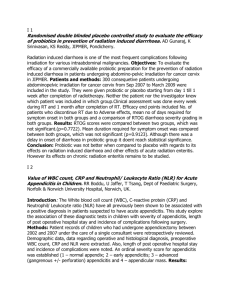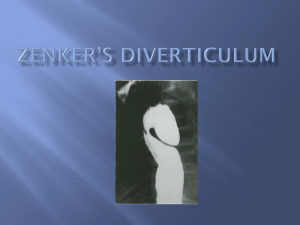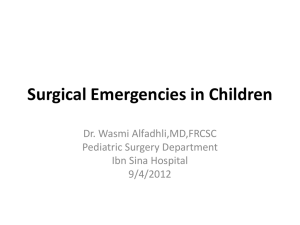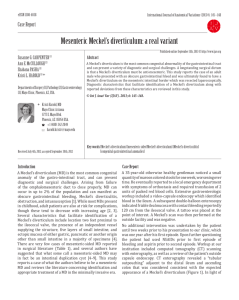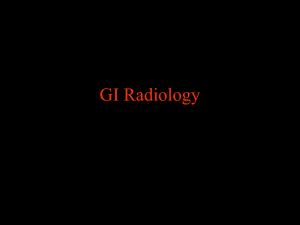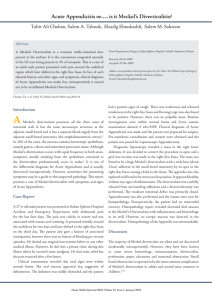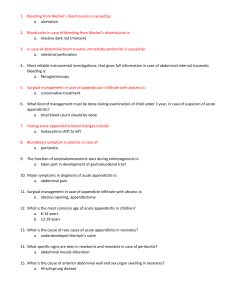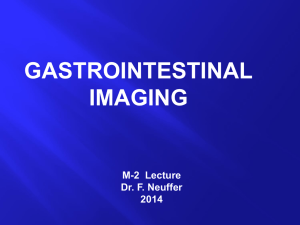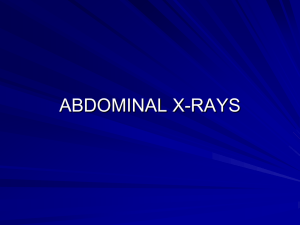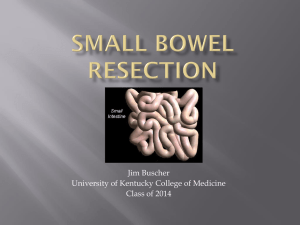Slides - Pilgrims Hospital
advertisement
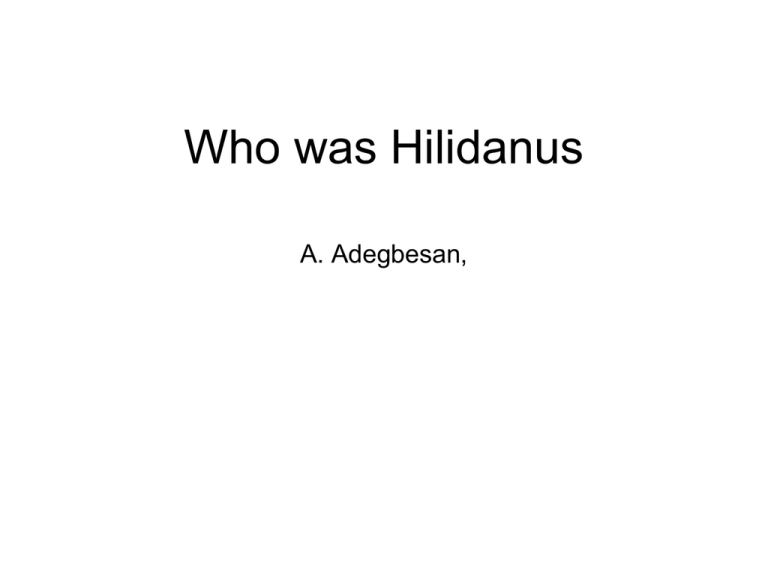
Who was Hilidanus A. Adegbesan, Case 1 • 68 year old lady admitted with a 2 day history of diffuse abdominal pain and vomiting. • Acute onset intermittent sharp epigastric pain, rated 7/10 with no aggravating or relieving factors. • Bowel motion and flatus last passed 3 day previously • Poor appetite. • No recent alcohol ingestion as per patient. Case History • Past Medical History: – – – – PUD Hiatus hernia Chronic Kidney Disease COPD • Past Surgical History – Hysterectomy – Cholecystectomy – Appendectomy Case History • Family History – Nil significant • Social History – Ex smoker • ROS: – Nil significant On Examination • Vital Signs: – – – – – BP 111/74 HR 92 Temp 36.2 RR 16 O2 SATS 100% on RA • Abdomen was not distended. Tenderness in epigastrium with mild guarding. No rebound. Bowel sounds exaggerated. Hernial orifices were intact. Investigations • WCC 7.4; Hb 13.3; Plts 433; CRP 17 • Urea 42; Na 125; K 7.4; Creat 609 (baseline 60-120) • ABG: pH 7.38, pCO2 4.57, pO2 12.4, HCO3 20 • Amylase 160 • ECG: NSR; tachycardic; tented T waves • CXR: no free air under diaphragm. • PFA: prominent small bowel loops Management • Initially admitted medically with – Acute on chronic renal failure – Dehydration • Upon surgical review: – Features of small bowel obstruction for conservative management. Management • Day 1 post admission: – Abdomen now distended, non tender, BS present. PFA showed progression - ? small bowel obstruction 2o to adhesions. • Day 2 post admission: – Medical review re: acute renal failure, hyperkalaemia and hyponatraemia. – Surgical team review – To continue conservative management – NG tube and urinary catheter placed Management • Day 5 post admission: – Renal failure indices resolved – Abdominal distension still persistent – Obstipated – PFA showed increasing bowel dilatation – NG tube active – Proceeded to laparotomy Operative findings • Small bowel volvolus with fulcrum around meckel’s diverticulum adherent to pelvic sidewall. • Merckel’s diverticulum and adjacent small bowel were resected and sent for histology. • Side to side anastomosis Post Operative • The post operative period was uneventful. • Histology – Gastric body type mucosa – No helicobacter pylori – No evidence of malignancy Case 2 • 31 year old gentleman admitted with: – 1/7 history of sudden onset non-radiating colicky lower abdominal pain. – No associated nausea, vomiting or altered bowel habit. – No previous medical/surgical hx. – ROS – nil significant On Examination • Vital Signs: • • • • BP 115/68 HR 93 O2 SATS 99% on RA Apyrexial 36.2oC • On examination: • Tenderness and guarding in lower abdomen • Reduced bowel sounds. Investigations • Urinalysis – NAD • Bloods – WCC 13.4 (neuts 10.58), Hb 13.4, CRP 49, Amylase 107 – Sickle cell screen negative • CXR – No air under the diaphragm • PFA – Bowel gas pattern normal. No bowel distension or obstruction. No free air. Investigations • CT Abdomen/Pelvis – Minor stranding of fat around a loop of small bowel in right lower quadrant (differential included inflammatory change around a meckel’s diverticulum) – Small nodes in the adjacent mesentery. – No evidence of large colonic diverticulitis and normal appearance of the appendix. CT Abdo/Pelvis Management • On admission: – IV fluids, co-amoxiclav and analgesia • Day 2 post admission: – Proceeded to Laparoscopy: • Operative findings: – Perforated merckel’s diverticulum which was resected at its base using Endo GIA and sent for histology – Appendix long and injected but not acutely inflamed - most likely not the cause of his symptoms but removed. Histological Findings • Ectopic gastric tissue at the fundus of the meckel’s diverticulum. • The excised edge was free of ectopic gastric tissue Introduction • A true congenital diverticulum, a congenital bulge in the small intestine. • It is a vestigial remnant of the omphalomesenteric duct • is the most frequent malformation of the gastrointestinal tract • It was first described by Fabricius Hildanus, German surgeon, in 1598 • Johann Friedrich Meckel, described the embryological origin of this type of diverticulum in 1809 Pathophysiology • It is a vestigial remnant of the omphalomesenteric (vitellointestinal) duct • Human embryos initially have convex umbilical loops of primitive gut that communicate freely with the yolk sac through the omphalomesenteric (vitellointestinal) duct • As development proceeds, the duct normally becomes occluded and disappears entirely by weeks 8-10 of gestation • Results from the failure of the vitelline duct to obliterate during the fifth week of fetal development Pathophysiology • The following anomalies are caused by the persistence of the omphalomesenteric (vitellointestinal) duct Epidemiology • Autopsy records show an incidence of about 2% in the general population. • For asymptomatic diverticula there is no gender predominance,. • For symptomatic diverticula some studies give a 3:1 male to female ratio, while others have detected little difference. • The risk of complications ranges from 425% in various studies. Anatomic Considerations • Meckel's diverticulum is located in the distal ileum, on its antimesenteric border. usually within about 60-100 cm of the ileocecal valve • It can also be present as an indirect hernia, typically on the right side, where it is known as a "Hernia of Littre." Anatomic consideration Topography of abdomen Anatomic Considerations • • • • • • A memory aid is the rule of 2's: 2% (of the population) 2 feet (from the ileocecal valve) 2 inches (in length) 2% are symptomatic 2 types of common ectopic tissue (gastric 80% , pancreatic, colonic and other tissues 20%), • The most common age at clinical presentation is 2, and • males are 2 times as likely Clinical features • • • • • Asymptomatic in majority of cases Painless rectal bleeding, Intestinal obstruction, Volvulus and Intussusception. Meckel's diverticulitis may present with all the features of acute appendicitis. • Epigastric pain & Bloating • Neoplasm - lipoma, leiomyoma, neurofibroma and angioma, leiomyosarcoma and carcinoid, which represent about 80% & adenocarcinoma and metastatic lesions Diagnosis • A technetium-99m (99mTc) pertechnetate scan is commonly used to diagnose Meckel's diverticulum – Gastric tissue. • Abd CT • Barium studies to out rule enterocolitis and intussuception • Laparoscopy • A bleeding scan. • Selective arteriography • Wireless capsule endoscopy • Abd USS Treatment • Surgical for symptomatic Merckel’s diverticulum • Incidental Meckel’s diverticulum in asymptomatic patients remains controversial – Narrow vs wide • Excision is carried out by performing a wedge resection of adjacent ileum and anastomosis • a primitive persistent right vitelline artery originating from the mesentery has been found during operation - Bleeding Histology • Heterotropic gastric mucosa 62% • pancreatic tissue 6%, • Both pancreatic tissue and gastric mucosa were found in 5%, • Jejunal mucosa was found in 2%, • Brunner tissue was found in 2%, and • Both gastric and duodenal mucosa were found in 2% Take home message • Meckel's diverticulum is the most common congenital abnormality of the gastrointestinal tract. • it is often difficult to diagnose • It may remain asymptomatic • it may mimic disorders such as Crohn's disease, appendicitis, peptic ulcer disease, obstruction and bleeding. Thank you • Who should take credit for this clinical entity • Fabricius Hildanus,, in 1598 • Johann Friedrich Meckel, 1809
